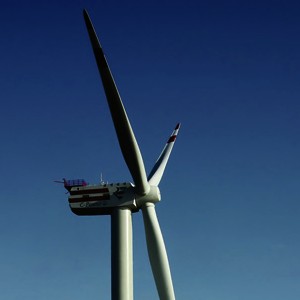Ramping up for renewables
by Neil Caudle

Nikolaos Rigas: “Instead of building a photovoltaic array, we’re building a device to emulate it.” Photo by Craig Mahaffey.
Now that the wind machines are up and running, bring on the sun.
Clemson’s wind-turbine drivetrain testing facility is one step toward building a national powerhouse in renewable energy research and development. Next up? The sun.
“We designed and are building a full-scale photovoltaic emulator,” says Nikolaos Rigas, executive director of the Clemson University Restoration Institute (CURI), which oversees work at the North Charleston campus. The emulator, attached to the Duke Energy Electric Grid Research, Innovation, and Development (eGrid) Center (see “Power Up,” Glimpse, Spring 2014), will simulate output from a photovoltaic (PV) array up to two-and-a-half megawatts—equivalent to a commercial-scale solar farm.
“This way we can do studies related to the large-scale PV systems without the need to have an actual PV array at the site,” Rigas says. “But more importantly, it will allow us to control the array, so we don’t have to wait for partial shading of the array by the sun, for example. We can program the device to emulate that for us.”
Like wind energy, solar energy offers strong potential but serious complications for the utilities that manage the nation’s electrical grid. Electrical production from wind and solar energy ebbs and flows somewhat unpredictably, a drawback for power grids designed for the regularity of plants powered by nuclear energy or fuels such as gas and coal. Also, a photovoltaic (PV) system generates electricity in direct current (DC) but requires an inverter to translate the DC power into the alternating current (AC) used on existing power grids.
Solar’s growing role
“When there wasn’t much solar out on the electrical grid, the utilities didn’t care what solar plants did or didn’t do,” Rigas says. “If they dropped out or had a fault, it didn’t matter, because the amount that supported the grid was so small. But now, when you’re having larger and larger percentages of the grid supported by photovoltaic arrays, utilities are expecting them to stay connected during transient events and to provide support.”
That means the industry needs “smart inverters” that could communicate with the grid and react more intelligently, rather than just taking the sun, converting it to power, and putting it out onto the grid, Rigas says.
To conduct the research necessary to help develop these smart inverters and other PV technologies, Clemson needed access to a large-scale photovoltaic array. “But instead of building a photovoltaic array, we’re building a device to emulate it,” Rigas says.
Like the virtual test bench Ryan Schkoda has been building in the wind-turbine testing facility, the virtual PV array will use computer-based simulation to model its performance and its behavior on the grid. And like the wind-turbine facility, the photovoltaic component will accommodate corporate clients who will plug their new technologies into the system for testing. So in one location, Clemson and its partners will have the capacity to model and test, on a commercial scale, next-generation technologies for the two leading sources of renewable energy in the U.S.: solar and wind.
A magnet for students
It’s a business model that works, Rigas says, not only for economic development but for teaching and research, because students and faculty researchers are directly involved in every aspect of the enterprise.
“Every single person employed at the facility is dedicated to supporting student education and research,” Rigas says. “It’s built into everybody’s job description.”
It’s an approach with powerful appeal for students at every level, from high school kids working as summer interns to undergraduate and graduate students working side by side with corporate clients, faculty, scientists, and engineers. In December, Clemson broke ground for the 50,000-square-foot Zucker Family Graduate Education Center along the waterfront at CURI. Rigas expects that the facility, which will feature an energy-efficient design, will be open for graduate engineering students in Fall 2016.
Following the car
The model for this blend of educating students, public/private partnerships, and conducting research in a commercial-scale facility didn’t happen by accident, Rigas says. It follows the example set by the Clemson University International Center for Automotive Research (CU-ICAR), which also includes corporate partnerships and the kind of dynamic testing and modeling required to engineer the automobiles of the future.
Imtiaz Haque, executive director of CU-ICAR at the time, helped Rigas craft the model along with a successful proposal to the U.S. Department of Energy, which provided $43.5 million, the center’s largest source of funding. “Doctor Haque was key in the development of this center,” Rigas says. “CU-ICAR had full-scale vehicle test facilities that Doctor Haque was involved with designing and building. So the concept that you see here was actually built off the experience at CU-ICAR.”
How do you tune a huge turbine to the forces of nature and help deploy the next generation of green-energy machines?
Whatever the source of renewable energy, electrical power on a commercial scale moves on a grid.
Nikolaos Rigas is the executive director of the Clemson University Restoration Institute (CURI) and a research professor in the College of Engineering and Science. Imtiaz Haque is the executive director of the Carroll A. Campbell Graduate Engineering Center and Founding Chair of the Department of Automotive Engineering at Clemson University’s College of Engineering and Science. Work on the new photovoltaic emulator will be led by Jesse Leonard, a research scientist who earned his Ph.D. working with a grid simulator at Florida State University. His project is part of the Duke Energy eGrid, whose director of operations is Curtiss Fox.
CURI reports to John Ballato, Clemson’s vice president for economic development.




